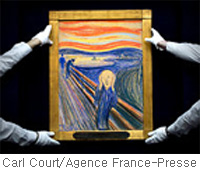 If I Had the Cash, I Wouldn’t Buy That
If I Had the Cash, I Wouldn’t Buy That
My first live encounter with “The Scream,” by Edvard Munch, was during a December stay in Oslo several decades ago. After a week of experiencing the sun-starved Norwegian midwinter, all dawn, dusk and oppressive darkness, I felt I knew where Munch’s image of released hysteria was coming from.
Since then “The Scream” has been subjected to the hard glare of the public spotlight. Two of the four existing versions of it have, at different times, been stolen from Oslo museums and later recovered. On Wednesday an 1895 pastel version of the picture sold for $119.9 million at Sotheby’s in New York, setting an auction record and proving, yet again, that whatever shape the economy is in, there’s no limit to private cash and art is a place where people like to park it.
And they like to park it in predictable places. What art could be more predictable than “The Scream,” one of the best-known images in the world? You can see why. Its essentials are readable from across a room. And with its skull head trapped under a shutting-down sky, it’s the pictorial equivalent of double exclamation points.
Some see the figure as a symbol of Modern Man, others as a kind of cartoon E. T. Either way there’s plenty of tasty narrative potential. Did something awful just happen? Is the shrieker nuts? Will he (or she) be leaping over the bridge rail next?
Frankly, it’s an easy thing to dis, but what’s the point? Pop Art and popular culture, from Andy Warhol to “The Simpsons,” have already done that pretty thoroughly. And despite it “The Scream” still holds a legitimate and complex place in the European painting tradition and in Munch’s estimable and interesting career.
Is a version worth $120 million? The only way I can answer is by asking another question: If I were suddenly handed the same amount of money for art, is that the way I’d spend it?
No.
After studying and writing about art for 40 years I see too many other options, options that would allow me to put together an encyclopedic mini-museum for the same dollars. That museum, filled with art that could be bought, even in these over-the-top times, for comparative bargain prices. It would begin with early Indian Buddhist art and go on to French illuminated manuscripts, African sculpture, tons of old master paintings and drawings — art that a new generation of collectors, fixated on thoroughly branded modern and contemporary art, doesn’t even know exists.
But even if I focused on modern and contemporary, I know where I’d spend. My museum would focus on, for starters, work produced by women, internationally, over the past 50 years. Some of the artists I’m thinking about call or called themselves feminists, though many don’t or didn’t. A huge percentage of current art comes right out of their work. Together it would be more than a collection; it would be a force. And given the low interest in and low prices of such art, I could probably pick up most of the work straight from studios and estates — no Sotheby’s commissions, thank you — and touch only a fraction of my $120 million museum fund.
Of course I never will start a museum, or, apart from an odd or end, an art collection. Part of me doesn’t warm to owning precious things. I’m glad there are museums where art can be kept, dusted and safe and out of my apartment. Personally I love ideas as much as objects, not that I can separate them: I feel ideas are as sensuous as things.
What I collect are experiences — traveling, seeing, being there, anywhere. For me “The Scream” will always mean the memory of a moody Oslo twilight from decades ago. The value of that experience to me is beyond price. When I hear $120 million, I think of how many experiences, for how many people, that might have bought.
 If I Had the Cash, I Wouldn’t Buy That
If I Had the Cash, I Wouldn’t Buy That